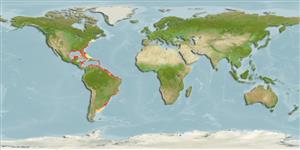Common names from other countries
Environment: milieu / climate zone / depth range / distribution range
Ecologia
marinhas; estuarina demersal; intervalo de profundidade 1 - 53 m (Ref. 9710). Subtropical; 46°N - 45°S, 98°W - 33°W
Western Atlantic: Canada (Ref. 5951) to Maine to Florida, USA (possibly from Nova Scotia, Canada), along coasts of central and south America (Ref. 26938) to Uruguay, including Bermuda and Gulf of Mexico (Ref. 9626). Rare in Greater Antilles (Ref. 26938).
Tamanho / Peso / Idade
Maturity: Lm ? range ? - ? cm
Max length : 48.3 cm TL macho/indeterminado; (Ref. 9626); common length : 35.0 cm TL macho/indeterminado; (Ref. 5217); peso máx. Publicado: 2.1 kg (Ref. 40637)
Espinhos dorsais (total) : 9; Raios dorsais moles (total) : 23; Espinhos anais: 3; Raios anais moles: 18. Pelvic fin small.
Adults are found in shallow coastal waters, usually over hard or sandy bottoms. Juveniles may be encountered in estuarine areas (Ref. 9626) and off sandy beaches (Ref. 5217). Found in schools, but may be encountered in small groups or in pairs (Ref. 26235). Adults feed on small crabs, shrimps, fishes, and worms. Flesh has excellent flavor (Ref. 5521). Marketed fresh (Ref. 9710).
Life cycle and mating behavior
Maturities | Reprodução | Spawnings | Egg(s) | Fecundities | Larvas
Robins, C.R. and G.C. Ray, 1986. A field guide to Atlantic coast fishes of North America. Houghton Mifflin Company, Boston, U.S.A. 354 p. (Ref. 7251)
Categoria na Lista Vermelha da IUCN (Ref. 130435)
CITES (Ref. 128078)
Not Evaluated
Ameaça para o homem
Reports of ciguatera poisoning (Ref. 30911)
Utilização humana
Pescarias: pouco comercial; peixe desportivo: sim; Aquário: Aquários públicos
Ferramentas
Relatórios especiais
Descarregue XML
Fontes da internet
Estimates based on models
Preferred temperature (Ref.
115969): 11.8 - 27.9, mean 24.2 (based on 648 cells).
Phylogenetic diversity index (Ref.
82804): PD
50 = 0.5039 [Uniqueness, from 0.5 = low to 2.0 = high].
Bayesian length-weight: a=0.01288 (0.01139 - 0.01457), b=2.94 (2.91 - 2.97), in cm Total Length, based on LWR estimates for this species (Ref.
93245).
Nível Trófico (Ref.
69278): 4.3 ±0.4 se; based on diet studies.
Resiliência (Ref.
120179): Médio, tempo mínimo de duplicação da população 1,4 - 4,4 anos (Preliminary K or Fecundity.).
Fishing Vulnerability (Ref.
59153): Moderate vulnerability (38 of 100).
